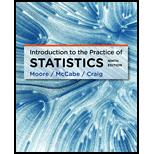
To test: The comparison of means of the two samples using significance test of pooled methods.
Answer to Problem 86E
Solution: The data strongly suggests that there is no significant difference between the means of early eaters and late eaters in terms of consumption of fat.
Explanation of Solution
Given: The data on total fats for early eaters and late eaters are provided. The summary of statistics fats consumption by the two groups are provided as:
Explanation:
Calculation: The significance test is to compare the means of two groups in terms of consumption of fats. Hence, the null hypothesis is that the consumption of fats in the two groups is the same as against the alternative that the consumption of fats in the two groups is not same.
Therefore, the hypotheses are formulated as:
In the above hypothesis,
The two-sample t- test statistic for pooled methods is defined as:
where,
First, determine the pooled sample standard deviation. The formula for pooled sample standard deviation is defined as:
Substitute the provided values and determine the pooled sample variance:
Now, determine the t- statistic. The difference of means is assumed as 0 in the null hypothesis. Substitute the provided values in the above-defined formula to compute the two sample t-statistic. So,
The p-value for the provided two-sided test is calculated as
So, the degrees of freedom are 400.
The Excel function to determine the p- value from t-test statistic is displayed in the screenshot below:

Conclusion: Therefore, the p-value is obtained as 0.1104, which is more than 0.05. So, do not reject the null hypothesis and hence it is concluded that the data strongly suggests that there is no significant difference between the means of the two groups in terms of fats consumption.
To find: A 95% confidence interval for the difference of means between early eaters and late eaters in terms of consumption of fats using pooled methods.
Answer to Problem 86E
Solution: A 95% confidence interval is
Explanation of Solution
Calculation: The confidence interval is calculated as:
where,
The pooled sample variance is obtained as 10.58 in the previous part. The critical value of t for 95% confidence level and 400 degrees of freedom is 1.9659. Substitute the provided values in the above-defined formula to determine the 95% confidence interval for the difference between the mean consumption of fats of two groups. So,
Interpretation: Therefore, the 95% confidence interval for the difference between the means is obtained as
To explain: The results obtained in the provided problem with those obtained in Exercise 7.71.
Answer to Problem 86E
Solution: The results are almost similar to those obtained in Exercise 7.71.
Explanation of Solution
The results obtained in this provided problem are:
Therefore, the results are almost similar.
Want to see more full solutions like this?
Chapter 7 Solutions
Introduction to the Practice of Statistics
 MATLAB: An Introduction with ApplicationsStatisticsISBN:9781119256830Author:Amos GilatPublisher:John Wiley & Sons Inc
MATLAB: An Introduction with ApplicationsStatisticsISBN:9781119256830Author:Amos GilatPublisher:John Wiley & Sons Inc Probability and Statistics for Engineering and th...StatisticsISBN:9781305251809Author:Jay L. DevorePublisher:Cengage Learning
Probability and Statistics for Engineering and th...StatisticsISBN:9781305251809Author:Jay L. DevorePublisher:Cengage Learning Statistics for The Behavioral Sciences (MindTap C...StatisticsISBN:9781305504912Author:Frederick J Gravetter, Larry B. WallnauPublisher:Cengage Learning
Statistics for The Behavioral Sciences (MindTap C...StatisticsISBN:9781305504912Author:Frederick J Gravetter, Larry B. WallnauPublisher:Cengage Learning Elementary Statistics: Picturing the World (7th E...StatisticsISBN:9780134683416Author:Ron Larson, Betsy FarberPublisher:PEARSON
Elementary Statistics: Picturing the World (7th E...StatisticsISBN:9780134683416Author:Ron Larson, Betsy FarberPublisher:PEARSON The Basic Practice of StatisticsStatisticsISBN:9781319042578Author:David S. Moore, William I. Notz, Michael A. FlignerPublisher:W. H. Freeman
The Basic Practice of StatisticsStatisticsISBN:9781319042578Author:David S. Moore, William I. Notz, Michael A. FlignerPublisher:W. H. Freeman Introduction to the Practice of StatisticsStatisticsISBN:9781319013387Author:David S. Moore, George P. McCabe, Bruce A. CraigPublisher:W. H. Freeman
Introduction to the Practice of StatisticsStatisticsISBN:9781319013387Author:David S. Moore, George P. McCabe, Bruce A. CraigPublisher:W. H. Freeman





